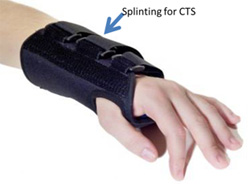Health Articles
What is Carpal Tunnel Syndrome (CTS)
Carpal tunnel syndrome (CTS) is a disorder caused by entrapment of the median nerve. Common symptoms includeparesthesia, pain, numbness, and other symptoms in the distribution of the median nerve due to its compression at the wrist in the carpal tunnel. However, pathophysiology still remains not completely understood with compression of the median nerve traveling through the carpal tunnel as the most likely cause. It also appears to be caused by a combination of genetic and environmental factors. Some of the predisposing factors include: diabetes, obesity, pregnancy, hypothyroidism, and heavy manual work or work with vibrating tools. It is uncertain whether lighter, repetitive tasks can also cause carpal tunnel syndrome.
The main symptom of CTS is intermittent numbness of the thumb, index, long and radial half of the ring finger. Numbness often occurs at night due to the hypothesis that the wrists are held flexed during sleeping hours. CTS for a long period of time without treatment can lead to permanent nerve damage with constant numbness, atrophy of the muscle of the thenar eminence, and weakened palmar abduction.Pain in carpal tunnel syndrome is primarily numbness that is so intense that it wakes one from sleep.In most patients with carpal tunnel syndrome, initial treatment is usually simple. The first options used for the treatment of carpal tunnel syndrome typically include anti-inflammatory medications (NSAID) and wrist splints. It is recommended that a wrist splint be worn at night while sleeping. The night splint holds the nerve in a relaxed position.The wearing of a wrist splint at night can relieve the symptoms caused by CTS as the splint can prevent wrist flexion.
Some doctors may recommend the use of a cortisone injection for the treatment of carpal tunnel syndrome before surgical treatment is considered. Cortisone injection is often a temporary solution, but it may lead to lasting relief of symptoms.If patients have persistent symptoms despite simple, conservative treatments of carpal tunnel syndrome, surgical treatment may be recommended. In order to make more room for the compressed median nerve, an incision is made directly over the carpal tunnel.When surgery is required for the treatment of carpal tunnel syndrome, the surgeon creates more room for the median nerve. Once the surgeon has made an incision over the carpal tunnel, the tight transverse carpal ligament is identified and cut with care to protect the median nerve. Once the transverse carpal ligament is completely cut, the nerve is free from compression.

The application of a night splint for the treatment of carpal tunnel syndrome.The wearing of a wrist splint at night can relieve the symptoms caused by CTS as the splint can prevent wrist flexion. As a result, the median nerve is held in a relaxed and uncompressed position.
Review Date: May 24, 2013
Reviewed by: Dr. Chen, Carl P.C., Medical Director, Department of Physical Medicine and Rehabilitation, C.G.M.H. Taipei.
References:
1. PAGE, M. J., O'CONNOR, D., PITT, V. & MASSY-WESTROPP, N. 2012. Exercise and mobilisation interventions for carpal tunnel syndrome. Cochrane Database Syst Rev, 6, CD009899.
2. MIRANDA, B. H., ASAAD, K. & CEROVAC, S. 2013. Carpal tunnel syndrome study: Local corticosteroids, conversion to surgery and NHS implications. J PlastReconstrAesthet Surg.
3. PAGE, M. J., MASSY-WESTROPP, N., O'CONNOR, D. & PITT, V. 2012. Splinting for carpal tunnel syndrome.Cochrane Database Syst Rev, 7, CD010003.